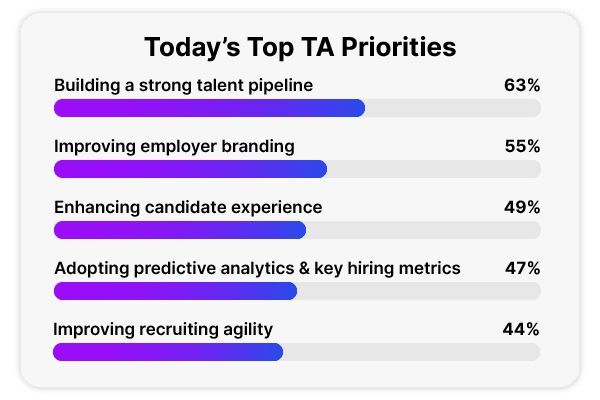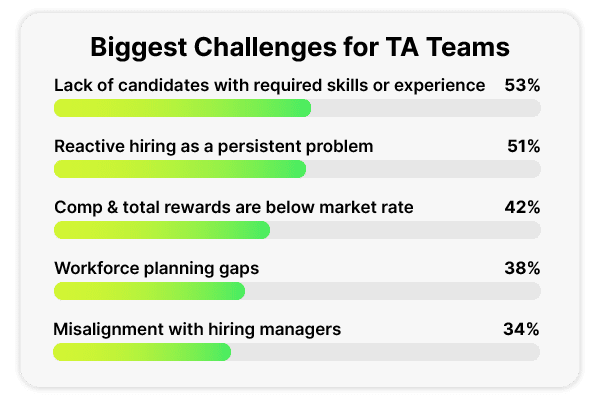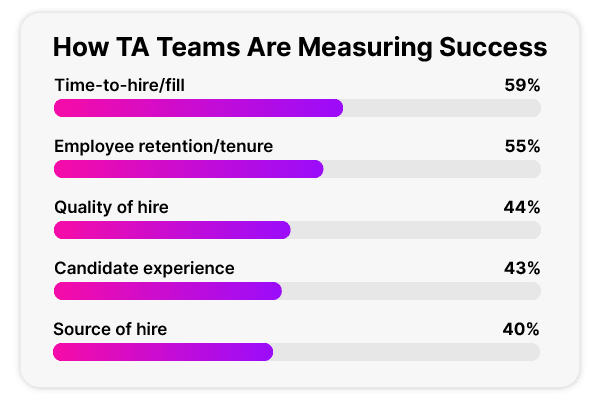From Reactive to Ready: Rival’s Take on the HR.com Future of TA Report
HR.com has released its much-anticipated 2025 Future of Talent Acquisition report, a comprehensive look at how talent acquisition (TA) teams are evolving, or struggling to evolve, in the face of growing hiring demands and resource constraints. The research, based on a global survey of HR professionals across company sizes and industries, paints a vivid picture of the future of TA—including where the field stands today and where it needs to go.
This research is always compelling, but here at Rival, we think this year’s report couldn’t have come at a better time.
As an all-in-one talent suite designed to help organizations source, hire, and retain top talent, we see firsthand what’s working—and what’s not—for TA teams. And while some of the report’s findings reaffirm trends we’ve seen in the market, others hit like wake-up calls. Especially for teams still stuck in reactive, ad-hoc hiring cycles while planning to meet higher headcount goals with flat budgets and limited technology adoption.
Most TA Teams Are Still Struggling to Get Proactive
According to HR.com’s research, 51% of organizations still rely on a “just-in-time” hiring approach—defined as reactive, tactical, and basic. Even more telling: nearly 9 in 10 organizations expect their hiring needs to remain the same or grow over the next two years, but only 30% plan to increase their talent acquisition budgets, and just 24% plan to add headcount to support that growth.
It’s clear that most TA teams will need to do more with less—and fast.
What Are Today’s Top TA Priorities?
The report surfaced several key priorities among HR leaders and TA practitioners.
We see these ambitions reflecting a shift in mindset—from transactional hiring to building a scalable, long-term talent strategy. But achieving them won’t be easy without major changes to how teams work.

Skills Gaps, Strategy Gaps, and Tool Gaps
The report also details where TA teams are feeling stuck—and the obstacles getting in the way are all too familiar.
Despite these challenges, the majority of organizations are not planning major upgrades to their TA toolsets. In fact, 54% say they don’t plan to invest in any new TA technologies over the next year.

And yet, technologies like AI-powered job descriptions, automated interview scheduling, and candidate outreach are cited as areas where innovation is expected to make the most impact.
There’s a paradox here: most TA teams know what would help—but haven’t yet made the leap.
This could, in part, be teams feeling overwhelmed by the sheer number of options available. The report shows that 38% of organizations are prioritizing both consolidating existing tools and adopting new ones, a strategic approach but one they have yet to fully realize.
How TA Teams Are Measuring Success
How are TA and HR teams keeping tabs on what success looks like?
For us, one stat jumps out here: 8% of organizations aren’t tracking any TA metrics at all—a risky move when the future of your workforce (and budget justification) depends on demonstrable impact.
TA leaders—defined in the report as those with mature, strategic acquisition functions—are far more likely to use these metrics and more.

For example, 66% of TA leaders track candidate experience, compared to just 27% of laggards. The same pattern applies across the board, from quality of hire to source channel effectiveness.
Three Standout Findings (and What They Really Mean)
While the HR.com report is full of revealing data, a few stats really stood out to us here at Rival. Here’s our take on what we see as three of the most surprising—and most actionable—findings in this year’s 2025 Future of Talent Acquisition report.

There’s a real disconnect here. More than half of organizations anticipate hiring more in the next two years, yet only a third are increasing their talent acquisition budget. It’s a mismatch that we believe could seriously hinder performance—especially if teams are expected to scale without the tools or staff to do so.
This is a signal that TA teams will need to get dramatically more efficient, fast. The organizations that thrive likely can’t be the ones that spend the most—so it must be the ones that spend smartest.
At Rival, we believe this is exactly where integrated, automated platforms and outbound recruiting shine. When you unify sourcing, hiring, onboarding, and development in one system—powered by automation and AI—you unlock time and budget in ways point solutions can’t. This stat confirms our belief that consolidation and efficiency will define the next generation of TA success.

One thing to understand about this stat is these aren’t external benchmarks or inferred—they’re directly based on self-reported maturity levels. Respondents of the survey were asked to place themselves on a five-stage maturity model, and only 1 in 20 saw their function at the highest level. Even more telling: a full 37% described their TA strategy as “advanced” but not “world-class.”
This suggests that many companies know what better looks like, but they haven’t yet crossed the bridge to get there. In our view, this isn’t a lack of awareness—it’s a lack of access, alignment, or capacity.
This stat reinforces a core belief of ours: world-class TA shouldn’t feel out of reach. Rival exists to help teams bridge that kind of maturity gap, with streamlined tools that guide TA from sourcing to onboarding and beyond. Whether it’s building a referral engine, automating passive sourcing, or improving offer-to-hire speed, the goal is the same: make “world-class” feel achievable, not aspirational.

This is one of the clearest indicators in the report that mindset—and maturity—directly shape outcomes. The HR.com research shows that in TA, some companies are “leaders” and others “laggards.” Nearly 9 in 10 TA “leaders” believe their hiring function is above average or top notch. For “laggards”, only 27% say the same.
This stat echoes something we see all the time: when organizations view talent acquisition as a strategic function, their results reflect that belief. TA “leaders” are far more likely to invest in data, automation, and strategic hiring approaches—and it shows.
This aligns with Rival’s focus on supporting the ambitious middle: teams that may not yet be “world-class” but aspire to be. Whether through AI-powered job descriptions, automated outreach, or seamless onboarding workflows, our goal is to help organizations build confidence and capability. We help them get there, and stay there.
Final Thoughts on the Future of TA
If there’s one theme that cuts across this year’s HR.com TA report, it’s this: the path to “world-class” talent acquisition is more visible than ever—but also more urgent. Teams know where they want to go. The challenge is finding a partner, a platform, and a process to help them get there.
At Rival, we’re building the tools to support that journey—from smarter sourcing to seamless onboarding to long-term employee development.
Whether you’re operating at full scale or just getting started, we’d love to help you move from reactive to ready. Let’s build the future of talent acquisition—together.


















